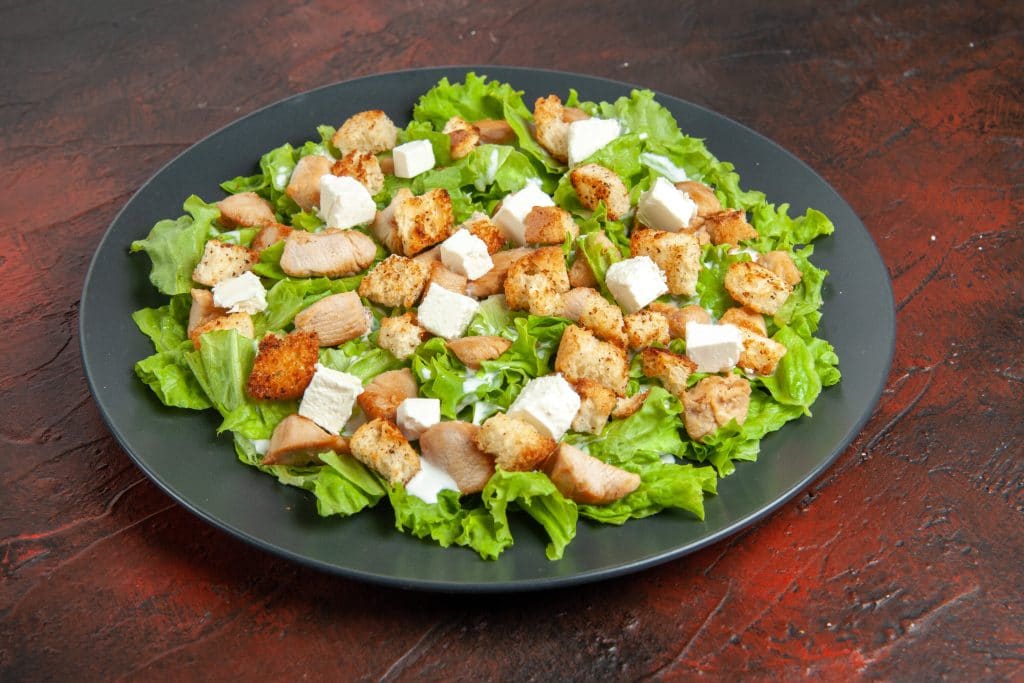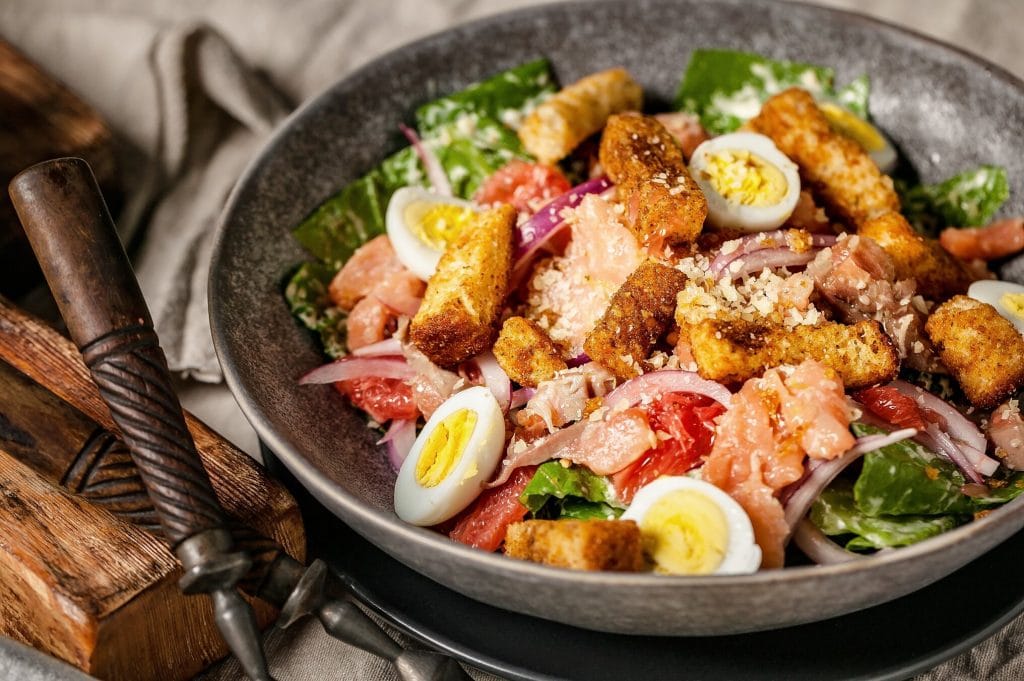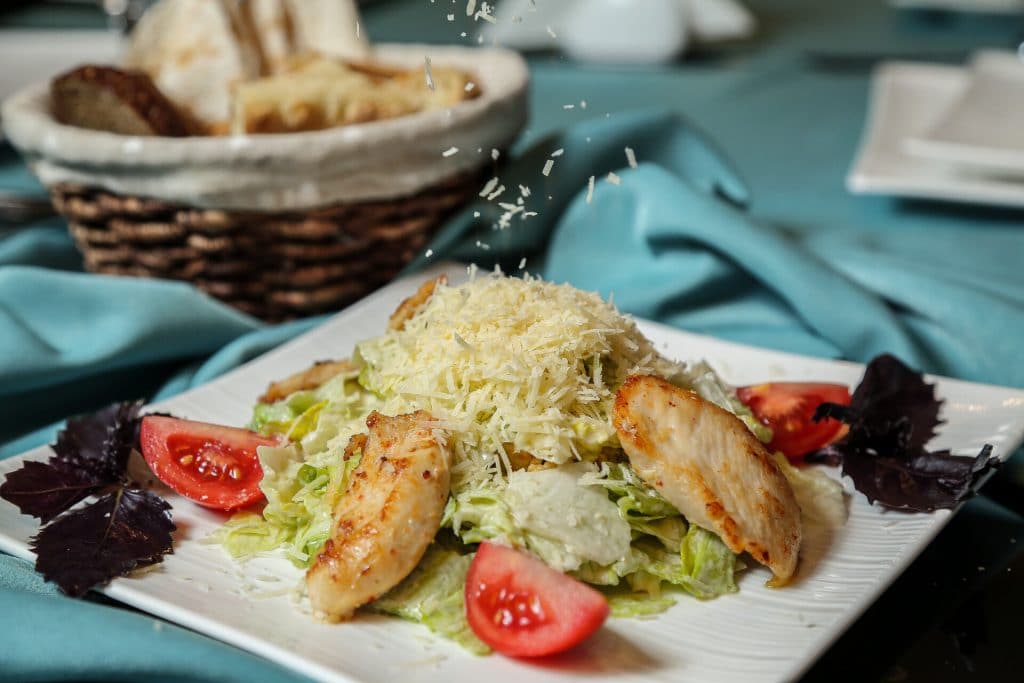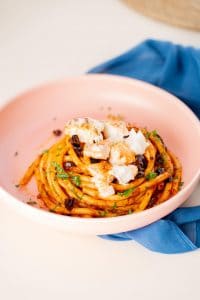What Fish Is In Caesar Dressing?
Important Note: When you buy through our links, we may earn a commission. As an Amazon Associate we earn from qualifying purchases. Content, pricing, offers and availability are subject to change at any time - more info.
It’s one of the most reknowned salads in America, and most decent restaurants usually have a signature version of it. If you’ve tried Caesar salad, you’ll know the dressing has a distinctly creamy, piquant taste. This taste comes from a combination of savory flavors, but you may be surprised to learn there is fish in the traditional Caesar salad dressing.
Traditionally, Caesar salad uses anchovy in the dressing ingredients. Some omit the anchovy and rely on the taste of the Worcestershire sauce to give it a distinct flavor. Worcestershire contains anchovies and tamarind extract, so even without whole anchovies, some anchovy flavor comes through.
While the very first Caesar salads didn’t actually use anchovies, the small, taste-packing fish has become a staple ingredient. If you’re going to make a traditional, modern Caesar salad, you’ll need to use anchovies. However, not everyone can eat anchovies, so we’ll list alternatives to consider.
- What Fish Is In Caesar Dressing?
- Traditional Ingredients in Caesar Salad
- What Does Anchovy Taste Like?
- Using Tinned Sardines
- Anchovy Substitutes
- Vegetarian Replacements for Anchovies
- So, What Fish Is In Caesar Dressing?
What Fish Is In Caesar Dressing?

Caesar salad has been a restaurant staple for decades, and you’ve probably enjoyed variations on it many times. Originally invented by an Italian immigrant to Mexico and the United States in 1924, it was something of a recipe of necessity. One of the ingredients added to this ‘tableside’ salad was the inclusion of Worcestershire sauce.
The story goes that Caesar (Cesare) Cardini invented the salad in Tijuana, Mexico, at his hotel Caesar. The restaurateur had to do some quick thinking when a 1924 Fourth of July rush wiped out his kitchen supplies. With his usual ingredients depleted, Cardini had to scramble together what he had on hand, and so the Caesar Salad was created.
Part of the appeal of a Caesar salad at the time was how it was presented — dramatically assembled ‘tableside’ by the chef himself. There was no anchovy in this original salad — the Worcestershire sauce provided a hint of anchovy already. These days, delicate pieces of anchovy are one of the staple ingredients in the dressing.
Traditional Ingredients in Caesar Salad

The modern standard Caesar salad recipe calls for whole cos lettuce (or romaine lettuce), served with a dressing made from:
- Olive oil
- Lots of crushed garlic
- Dijon mustard
- Lemon juice (originally lime, but this changed through the years)
- Worcestershire sauce
- Anchovies
- Eggs (raw or coddled)
- Topped with grated Parmesan cheese and croutons
As you can see, the star of this salad is the dressing. Although there are many variations that include using different salad greens or adding meat like chicken or bacon, the unique flavor of a Caesar dressing comes from that incredible combination of the egg for creaminess, and Worcestershire sauce and anchovies for the punch of salty, umami flavor.
What Does Anchovy Taste Like?

Anchovies are small saltwater fish that are traditionally preserved by salting them in brine. Once processed, they are packed in oil or salt and jarred or canned. This method of preservation is what accounts for their very intense flavor. When fresh, anchovies have a much milder flavor.
Most commonly, anchovies will be packed in oil, making them easier to use. Anchovies packed in salt require a little more preparation before using but are usually firmer, with a sweeter, meatier taste. Preserved anchovies have a very intense tender, meaty and fishy taste, coupled with a strong salty flavor.
If the anchovies were not cured long enough, they may have a chemical or mealy flavor and feel gritty in texture. For this reason, when using anchovies in salads where they are the star ingredient, we recommend going for top-of-the-line brands rather than the cheapest options.
Because of the intensity of their flavor, sardines are used in small amounts in many dishes and to create sauces like Worcester sauce.
Once you’ve opened a jar or can, you can store them in the refrigerator for six months, provided the oil still covers them.
Using Tinned Sardines

Although tinned sardines are usually cheaper and readily available, they are not a direct alternative to anchovies. They have a completely different flavor and don’t pack the salty punch necessary. They are also larger and have a different texture to anchovies.
Having said that, some chefs do have recipes that use canned sardines, as they are a more sustainable option.
Some people prefer sardines as they are a healthier option as they are processed with less salt. If you’re looking for the best sardines to use in your Caesar salad dressing, we have compiled a list of the Best Sardines in Olive Oil for you.
Anchovy Substitutes
Some people absolutely love anchovies — and I’m one of them — but the fishy taste is overwhelming for others. You can leave the anchovies out altogether if you prefer not to have such a strong fish flavor to your Caesar dressing. The anchovies used in the making of the Worcestershire sauce will add that subtle fishy tang without being too strong.
If your problem is not so much with the taste but that you don’t have anchovies on hand, there are a couple of alternatives you can add to your dressing to help emulate the anchovy flavor.
Worcestershire Sauce
Worcestershire sauce comes from a long tradition of fermented anchovy sauces in Europe — dating right back to Ancient Rome, where it was called garum. Worcestershire sauce uses different kinds of vinegar, molasses, sugar, tamarind extract, and anchovies among its ingredients.
It’s already one of the main ingredients in a Caesar dressing, but if you do not have anchovies, you could try increasing the amount of Worcestershire sauce in the recipe. Another tip is adding some capers for a tangy, more robust olive flavor.
Using only Worcestershire sauce will make your dressing more runny than usual, and you will lose some of the thick, salty creaminess of the consistency of a good Caesar dressing.
Fish Sauce
Fish sauce is an Asian condiment made from fermented fish or krill. Thanks to its intense, rich flavor, it’s a staple in Southeast Asian and East Asian cooking, and many western cooks now use it. It’s usually salty, with a watery texture, and is most often made from anchovies in Southeast Asia. It’s not as sweet as the closely related oyster sauce.
Other varieties of fish can be used, depending on where the sauce comes from. For example, Chinese fish sauce is usually made with Reeve’s shad, while Japanese variations can be made from sardines or even squid.
While not all fish sauces will have the defining anchovy taste, they will impart a rich umami flavor to your Caesar dressing. However, Asian fish saucemay not be the most effective replacement if anchovies are unavailable because it is pretty thin. Add too much, and the sauce could become too runny.
Fish sauces are generally quite intensely flavored, so err on the side of caution and add only a few drops to your dressing. If you want a stronger fish flavor after taste-testing, you can add more.
Remember that fish sauce will not taste exactly the same as anchovies, and your Caesar salad dressing may have a slightly more metallic and fishy taste than expected.
Anchovy Paste
One of the most effective substitutes for chopped anchovy pieces in a Caesar dressing is anchovy paste. This is a condiment made from anchovies and some other ingredients, which are processed into a paste. This paste is often made using the leftover anchovies from the anchovy packing process to avoid waste. It’s a popular condiment worldwide and used as an ingredient in many dishes.
Once opened, you should keep anchovy paste in the fridge, but it has a relatively long shelf life due to the high salt content.
If you decide to use anchovy paste as a substitute for anchovies in a recipe, estimate 1/2 teaspoon paste per anchovy.
Shrimp Paste
Another fermented condiment from Southeast Asian and Southern Chinese cooking, shrimp paste, is made from salt-packed, crushed shrimp or krill. This paste is fermented for several weeks.
The most common variety available in America is Thai brand shrimp paste, usually found in Asian specialty food markets.
While it will not replicate the taste of anchovies, it will add a similar fishy punch to your meal. Be aware that shrimp paste tends to have a more robust flavor than fish paste.
Vegetarian Replacements for Anchovies
While no one ingredient will exactly replace anchovies, there are some options for you to consider. If you are unable to eat fish or are avoiding fish due to dietary restrictions, you may want to replace the anchovies with another vegetable-based sauce or paste.
If you are doing so, remember to replace the Worcestershire sauce, as it contains trace amounts of anchovies. Some companies make vegan brand Worcestershire sauce, which may also be an option.
Here are some suggested alternatives for anchovies and anchovy-based sauces.
When making a strictly vegan Caesar dressing, you will also have to find taste alternatives for the eggs and parmesan.
Soy Sauce
Traditionally made from fermented soybeans, soy sauce has been used in Chinese cooking for thousands of years.
Many people use soy sauce to replace Worcestershire sauce in vegan recipes. While the flavor will not be close, it will add some of the salty, umami flavor needed in your Caesar dressing. Combine with one or more of the suggestions below when making your dressing.
Miso
Like soy, miso is made by fermenting soybeans and other ingredients such as rice or barley. The process creates a thick paste that is widely used in Japanese cooking for its salty, earthy flavor. The taste profile will depend on the fermentation process used, and some brands can have a sweeter taste while others are more savory.
Red and white misos are the ones most commonly available, and these days miso paste is available at most grocery stores, or easily bought online at Amazon.
Umeboshi Paste
In Japanese cuisine, umeboshi paste is made by fermenting a species of sour plum, known as ume. Vegans have discovered it makes an excellent savory, salty replacement for recipes calling for anchovy paste, fish sauce, or Parmesan cheese.
As you can imagine, this makes umeboshi paste perfect for recreating a vegan version of Caesar dressing. The acidic sharpness of umeboshi paste paired with capers and a little tamarind help to create the flavor profile you would want from a vegan Caesar salad.
Kalamata Olives
Black Kalamata olives are a great choice when replacing the anchovies in Caesar salad. Their briny flavor is excellent in a Caesar salad dressing. Using Kalamata olives instead of anchovies and perhaps substituting feta cheese is a great way to make a Greek twist on this American-Italian favorite.
Capers
The green buds of the caper bush are pickled in salt and vinegar to create these little packets of slightly sour, salty flavor. They are a good substitute for anchovies in vegan alternative recipes, common in Mediterranean cuisine. Rinse them clean of vinegar before using, and use ½ Tbsp in place of 1 tsp anchovy paste or 2 anchovies.
Seaweed
Are you looking to add that salty ocean taste without using fish? Definitely look at getting dried seaweed flakes and crumbling them into your dressing. Seaweed is an excellent way of getting an authentic ‘fish’ taste without fish. Popular edible seaweeds include nori, kobu, wakame, and dulse. A simple way to add seaweed to your dressing is by crushing a single pack of roasted seaweed snacks and using the flakes.
Seaweeds are also wonderful sources of iodine and tyrosines, two things known to support the function of your thyroid. Seaweed is a good source of different minerals and vitamins, so it’s a good idea to include it in a vegan diet, and what better way than in a delicious Caesar salad dressing.
So, What Fish Is In Caesar Dressing?

While anchovies are the primary taste driver in the traditional Caesar salad dressing, you have many options to use if you have no anchovies on hand or prefer not to eat them. Experiment with the various ingredient combinations above to get a flavor that works for you.
If, like me, you can’t get enough of the salty, rich flavor of sardines, I would always recommend buying the best quality sardines available to you. Using high-quality ingredients, you’ll find your Caesar salad dressing will pack a rich, savory punch that will have everyone coming back for more.
























